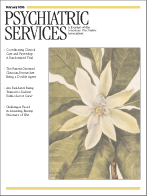Randomized Trial of Psychiatric Care With Representative Payeeship for Persons With Serious Mental Illness
Abstract
OBJECTIVES: This randomized clinical trial assessed whether a community-based representative payee program that was coordinated with psychiatric care from the Department of Veterans Affairs was more effective than customary treatment. METHODS: In the experimental condition representative payeeship was provided by a community agency that worked to enroll clients and coordinate payeeship with clinical care through communication with clinical staff. The control condition consisted of customary clinical care that included the typical availability of representative payeeship. Hypotheses were that, compared with the control group, the experimental group would experience greater enrollment in a representative payee program; improved residential status; improved quality of life, including fewer symptoms of mental illness; less substance abuse; and improved money management. Participants were interviewed at baseline and at six and 12 months. Outcomes were analyzed with analysis of covariance by using covariates from the baseline. RESULTS: A total of 184 participants were enrolled at baseline (94 in the experimental group and 90 in the control group). A total of 152 interviews were completed at six months, and 149 were completed at 12 months. At 12 months, 31 percent of patients in the experimental group and 14 percent of those in the control group were receiving representative payee services. At 12 months, significant positive effects were observed for the experimental group on enrollment in a representative payeeship, alcohol and drug use, quality of life, and money management. Residential status approached significance. CONCLUSIONS: Use of a coordinated representative payee program was found to be effective in improving outcomes at 12 months. Although this evidence supports the wider implementation of a coordinated representative payee program, only 31 percent of the experimental group had their money banked with a representative payee. Therefore, future studies should focus on achieving a better understanding of the causal components of the intervention.



